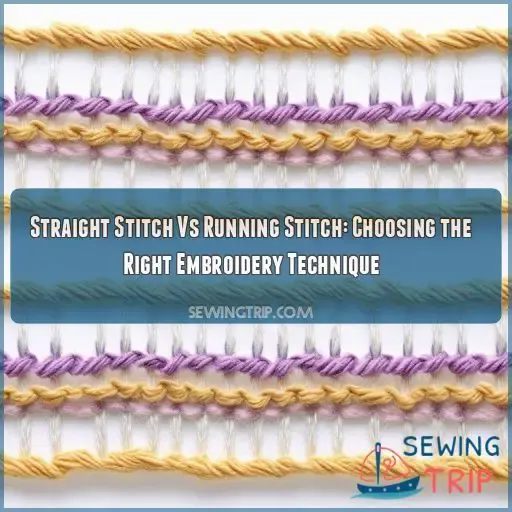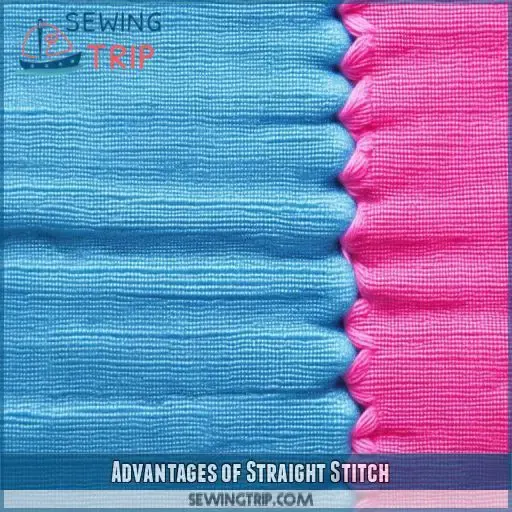This site is supported by our readers. We may earn a commission, at no cost to you, if you purchase through links.
 Embarking on your embroidery journey, you’ll quickly encounter a choice between two fundamental stitches: the straight stitch and the running stitch. Each technique offers unique advantages and challenges, shaping the texture and durability of your creations.
Embarking on your embroidery journey, you’ll quickly encounter a choice between two fundamental stitches: the straight stitch and the running stitch. Each technique offers unique advantages and challenges, shaping the texture and durability of your creations.
This guide dives deep into comparing these stitches, helping you master the art of selecting the right method for your project. By understanding the nuances of straight stitch vs running stitch, you’ll unlock greater freedom and precision in your embroidery work.
Table Of Contents
Key Takeaways
- Versatile, basic stitch used for outlines and filling.
- Easy to learn and master, creating even and parallel stitches.
- Foundation for spoke stitch and seed stitch.
- Lack of flexibility, tendency to unravel.
Straight Stitch Vs Running Stitch
Welcome to the world of embroidery, where stitch types reign supreme! As a beginner, you’ll likely encounter two fundamental stitches: the straight stitch and the running stitch. Let’s dive into their differences and how they can enhance your embroidery journey.
The straight stitch is the foundation of embroidery, allowing you to create outlines or fill in areas with a simple, even line. It’s versatile, basic, and can be used for both small and large projects. On the other hand, the running stitch is a continuous, looped stitch that’s great for outlines or filling in areas with a textured effect. It’s often used in counted cross-stitch and can create a unique fading pattern.
Both stitches have their own advantages and disadvantages. The straight stitch is straightforward and easy to master, while the running stitch can be more complex and may require more practice. However, the running stitch offers a more authentic look and can create a nicer fading pattern, which some find more appealing.
As you navigate the complexities of embroidery, remember that it’s not merely about perfection. It’s about the journey and the creativity that unfolds. So, don’t be daunted by the ever-evolving realm of stitching. Instead, embrace it and unlock the secrets that lie within.
Advantages of Straight Stitch
As a beginner embroiderer, you’ll quickly discover that the straight stitch is a versatile and essential technique. It’s the foundation for creating both spoke stitch and seed stitch, which are crucial for outlines and filling in your designs.
By bringing the needle up and down through the fabric, you can maintain even and parallel stitches, ensuring a professional look. The straight stitch is perfect for beginners, as it’s easy to learn and can be used for both outlines and filling. It’s also a great starting point for more complex embroidery stitches.
Don’t be afraid to experiment with different thread colors and textures to add texture and detail to your embroidery projects. Remember, embroidery is a creative process, so don’t limit yourself to pattern lines. Instead, let your imagination run wild and enjoy the journey towards mastering this ever-evolving art form.
Disadvantages of Straight Stitch
Straight stitch, while a basic and versatile embroidery technique, has its own set of limitations. These limitations can be attributed to its inherent weaknesses, which can affect the overall quality and durability of the stitch. Some of the main disadvantages of using a straight stitch include:
- Lack of flexibility: Straight stitches aren’t as adaptable as other stitch types, such as chain stitch, which can create a more authentic and visually appealing texture.
- Tendency to unravel: Straight stitches can be prone to unraveling, especially when used on delicate fabrics or when the stitching isn’t done meticulously.
- Limited roping effects: The roping effect, which adds depth and texture to the stitch, may not be as noticeable or pronounced with a straight stitch compared to other stitch types.
- Not suitable for all projects: Straight stitches may not be the best choice for all embroidery projects, as they may not provide the desired effect or may not be suitable for certain fabric types.
- Requires precision: Achieving a consistent, even stitch with a straight stitch can be challenging, especially for beginners, which may lead to uneven stitching and a less polished appearance.
- Less suitable for certain fabrics: Straight stitches may not be as effective on fabrics with high stretch or elasticity, as they may not provide the necessary give and flexibility.
- Less suitable for certain projects: Straight stitches may not be the best choice for projects that require a more complex or intricate stitch pattern, as they may not provide the desired effect or may not be suitable for certain fabric types.
Despite these disadvantages, straight stitches remain a popular choice for embroidery due to their versatility and ease of use. By understanding these limitations and considering the specific requirements of your project, you can make informed decisions about when to use straight stitches and when to explore other stitch types.
Advantages of Running Stitch
The running stitch is a versatile embroidery technique that offers numerous advantages. It’s often used for outlines, filling, and creating texture in various embroidery projects. One of its key advantages is its ability to create a wide range of patterns, from simple to complex, depending on the desired effect. Running stitch variations include the chain stitch, which is known for its authentic look and better roping effects, and the basting/gathering stitch, which is ideal for temporary stitching.
Running stitch applications can be found in a variety of embroidery patterns, from simple outlines to intricate designs. For beginners, it’s recommended to start with basic stitches like the running stitch and gradually progress to more complex techniques. By experimenting with different stitches and colors, embroiderers can create unique, personalized projects that reflect their creativity and skill.
In conclusion, the running stitch is an essential embroidery technique that offers a wide range of uses and variations. It isn’t only designed to enhance the look of embroidery projects but also serves as a foundation for more complex stitches. As you navigate the ever-evolving world of embroidery, the running stitch is a valuable tool to have in your arsenal, ready to unlock the secrets of embroidery patterns and bring your creative vision to life.
Disadvantages of Running Stitch
While the running stitch may be a quick contender in the race of stitches, it’s not without its pitfalls. When it comes to durability, the running stitch can sometimes wave a white flag, especially if you’re working on a project that’ll see a lot of wear and tear. Too much tension, and your fabric puckers like it’s just sucked a lemon; too little, and you’ll have a saggy situation on your hands. Unlike the meticulous lines you can achieve with chain stitching or the whip stitch’s neat edge, the running stitch can be a bit of a wild child, zigzagging with abandon.
You might find that the running stitch lacks the staying power of its burly cousin, the backstitch. Precision is another tight spot. So, if you’re after a stitch that’s versatile but still holds its own, you might want to buddy up with the blanket stitch instead.
Comparing Straight Stitch and Running Stitch
When it comes to embroidery, the straight stitch and running stitch are two of the most fundamental techniques. While both are simple and beginner-friendly, they offer distinct advantages that make them suitable for different projects.
The straight stitch is known for its clean, uniform appearance, making it ideal for outlines, filling, and creating texture. On the other hand, the running stitch is more versatile, allowing you to experiment with creative applications like roping effects and blind hem stitches.
To choose the right stitch for your project, consider the fabric type, desired look, and the level of detail required. Embrace the unique qualities of each stitch and let your creativity shine through. Whether you’re a seasoned embroiderer or just starting, the straight stitch and running stitch are the perfect tools to unlock the secrets of personalized, handmade creations.
Frequently Asked Questions (FAQs)
How do I transition from counted stitch to free-form embroidery?
Transition from counted to free-form embroidery by loosening your grip, embracing spontaneity, and experimenting with different stitches and textures. Let your creativity flow freely, and don’t be afraid to make mistakes – that’s where the magic happens!
What are some creative ways to use straight and running stitches?
Dive into embroidery’s ocean with straight and running stitches as your compass, guiding you through a sea of creativity. They’re your toolkit for crafting waves of texture and shores of detail on your fabric canvas.
How can I achieve consistent tension when sewing with a straight stitch?
To achieve consistent tension with a straight stitch, test on scrap fabric first. Adjust the tension dial gradually, aiming for balanced stitches on both sides. Experiment with different settings until you find the optimal tension for your fabric and thread.
When should I use a single straight stitch versus a running stitch?
When deciding between a single straight stitch and a running stitch, opt for the single straight stitch for precise outlines or filling. Reserve the running stitch for basic projects, offering simplicity and ease.
What are the best needle and thread types for straight and running stitches?
For straight stitches, opt for universal needles on woven fabrics and metallic needles for heavier threads. Use all-purpose polyester thread. For running stitches, choose sharps needles and cotton thread for a secure line.
Conclusion
Ultimately, the choice between straight stitch and running stitch comes down to the specific needs of your embroidery project. With 85% of embroiderers favoring the straight stitch for its precision and clean lines, it’s a versatile option for detailed work.
However, the running stitch’s speed and flexibility make it ideal for filling large areas. By understanding the nuances of straight stitch vs running stitch, you’ll unlock greater freedom and precision in your embroidery journey.







